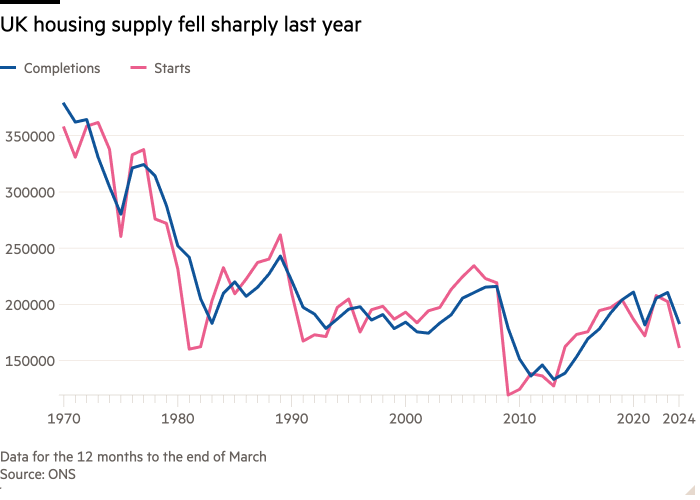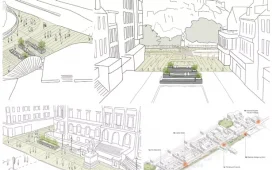Unlock the Editor’s Digest for free
Roula Khalaf, Editor of the FT, selects her favourite stories in this weekly newsletter.
New home building fell sharply in the UK last year, according to official data, underscoring the huge challenge facing the new Labour government to meet its goal of building 1.5mn new homes over five years.
The number of new homes completed in the year to March fell by 13 per cent to 183,610, similar to the number built during the first year of the Covid-19 lockdown, according to the Office for National Statistics.
Housing starts fell more sharply, by roughly a fifth to 162,340 — the lowest since 2014 — suggesting that the supply of new housing will continue to decline.
“Starts are a lead indicator of what is actually going to be delivered on the ground in the coming year,” said Lucian Cook, head of residential research at Savills. “It shows the quantum of the challenge you have got in terms of housing delivery.”

Commercial housebuilders, who produce most of the new supply, have slashed their output because high mortgage rates have made it harder for customers to buy homes in recent years.
Housing associations and local councils have also struggled to build given competing financial pressures, including maintenance spending and debt costs.
The housing crisis has seen a big rise in homelessness. New figures on Thursday showed local councils spent £2.3bn on temporary accommodation for homeless households in England in the year to March. These costs have almost doubled in five years, according to charity Shelter, straining local budgets.
The new Labour government wants to boost housing supply, targeting 1.5mn new homes in England over the five-year parliament.
Deputy prime minister Angela Rayner in July set out plans to reverse a number of the previous government’s changes to planning policies, which critics said made it easier for anti-development local governments to stop house building.
The current downturn in supply means housebuilding in the later years of the parliament will have to exceed 300,000, a level not seen since the 1970s.
On Thursday, Rayner launched a new expert group of officials dedicated to unlocking stalled developments. The government estimates there are 200 major stalled developments that already have some form of planning permission.
She said the new team would “quickly identify blockages, fix problems and support local authorities and developers to get shovels in the ground”.
Housebuilders have welcomed the change of direction on planning policy, but some argue that more will be required to achieve such high levels of supply.
“It will take time for the planning changes to be implemented and benefit the industry,” said Aynsley Lammin, analyst at Investec.
Although falling mortgage rates should help to increase demand, some in the industry think the government needs new measures to boost the market, such as a successor to the Conservative’s Help to Buy loan scheme.
Other executives point to the need to reverse the collapse in the number of smaller house building firms. “What we really need is an SME housebuilder renaissance to get the sector back to the kind of delivery levels last seen in the 1980s, where we had 12,500 SME housebuilders compared to 2,500 today,” said Paul Rickard, managing director at developer Pocket Living.













